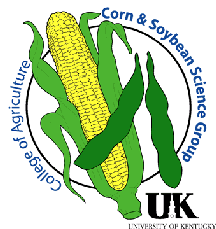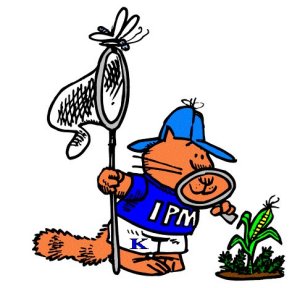|
Flooded Soybeans Near Harvest
Chad Lee and Jim Herbek, Plant and Soil
Sciences, Don Hershman, Plant Pathology and Sam McNeil, Biosystems and
Agriculture Engineering
Soybeans in several areas of Kentucky
received excessive rain and were submerged either partially or
completely. In most cases, the soybeans had reached maximum seed
weight and were drying down for harvest.
Determining yield losses from flooded,
mature soybeans is extremely difficult and no accurate prediction will
likely be made. We know that flooding is not a good thing for
soybeans, we just can’t say how bad it may be. Below are several
things that could occur along with suggestions on management.
Possible Scenarios from Flooding
1. Sprouting in the pod. Soybean seeds
that have dried below 50% moisture and imbibe water to rise back above
50% moisture can germinate. Aside from getting the water off of the
field as quickly as possible, there is nothing a farmer can do to
prevent the germination of seeds in a pod.
2. Shattering. Once these plant dry out
again, shattering of the pods is a very good possibility. With the
thought of shattering, most farmers will be tempted to harvest these
soybeans as soon as the seeds have dried enough for harvest.
Harvesting these soybeans early must be weighed against some of the
other things that might occur in the field.
3. Saprophytic fungi. The moist, dead
soybean plant material is a good host to saprophytic fungi. These
could discolor some soybean seeds. They could cause clouds of black
dust during harvest. Scout the fields to see if the fungus has gotten
to the seeds. If the fungus is not on the seed, then you may want to
harvest these as soon as possible to prevent any additional seed
damage. If the seeds have been infected with a fungus, then deciding
when to harvest becomes more difficult. Some of the other scenarios
presented here may help in that decision. These soybeans should be
kept separate from soybeans harvested from dry or clean fields.
4. Lodging of plants. This lodging
most likely will occur from the rapid movement of water into or out of
the field. These plants will likely be covered in mud and silt, so
some seeds will be lost to the ground. The remainder will be difficult
to harvest. Lodged plants in contact with the soil or covered with
mud, silt and debris will probably result in increased deterioration
of the seed and poor seed quality. The farmer cannot prevent these
soybeans from lodging. Harvesting will be very slow and harvest losses
are very likely in this situation.
5. Silt and mud. Flooding brings water
and soil. As the water recedes, the soil is left on the plant
material. The silt can delay drying out of the plants and will create
some very dusty soybeans at harvest. Moreover, it will cause extra
wear and tear on the combine harvesters. If the soybeans are standing
and the farmer can wait, it would ideal to harvest these soybeans
last, so as to keep the combine relatively clean for fields of
soybeans that were not flooded. .
6. Grain Quality. Monitor each field
for grain quality prior to harvest. Flooded fields will most likely
have reduced seed quality affecting marketability. Depending on the
extent of damage, this may result in heavy dockage or unacceptability
at elevators.
7. Soybeans not Mature. Late planted
soybeans that had not reached physiological maturity (R7) and were
flooded for more than 24 hours, will most likely not survive,
resulting in pre-mature death of the plants. In these cases, you can
expect reduced seed quality (green and off-color seed, shriveled and
smaller seed). The extent of seed quality damage will be dependent on
the plant reproductive stage when flooding occurred. Fields with
considerable green foliage (R5 to early R6) would be of greatest
concern for reduced seed quality. Monitor each field to determine if
harvest is a feasible option.
Suggested Management
1. Separation. Soybean seeds harvested
from flooded fields should be kept separate from soybeans harvested in
other fields. Seed quality may be reduced in flooded fields. Mixing
soybeans from flooded fields with soybeans from dry fields could
reduce the quality of the overall load of soybeans.
2. Harvest order. Above are some
conflicting situations on when to harvest flooded soybeans. On the one
hand, flooding will probably increase lodging and shattering. Both are
reasons for harvesting the fields as soon as possible. On the other
hand, dust and silt are reasons for harvesting these fields last.
Fungi, depending in the severity could go in either category. Final
harvested yield in flooded soybean fields is likely reduced; we are
not sure by how much. Harvesting flooded soybeans could take longer,
especially if plants have lodged, are muddy or dusty from silt and/or
fungi. If multiple fields of soybeans are ready to harvest at the same
time, consider harvesting the better, dry fields first. Harvest yield
losses were not reduced in these fields and they can be harvested
quicker than the flooded fields.
3. Heavily damaged fields. For soybean
fields that received extensive flood damage and will likely result in
considerable harvest yield losses or very poor seed quality, then
pursuing crop insurance claims (if it is an option), may be the best
choice.
4. Scout the fields. To determine the
extent of flood damage and harvest order, these fields will need to be
scouted. Deciding which fields to harvest first will depend on the
situation for each farmer. County extension agents are available for
help in making these decisions.
Related Information:
Penn State
Managing Flood Damaged Crops (corn
silage, corn and soybeans)
(Greg Roth, et al. 2006)
http://cornandsoybeans.psu.edu/flood_damaged_crops.cfm
and
Management of Pre-Harvest Flood Damaged
Corn and Soybeans
(Tom Murphy, et al. 2005)
http://crops.confex.com/crops/2005am/techprogram/P4612.HTM
The Capital-Journal (Topeka, KS) article from Oct.
2005 that quotes a farmer (“I have a $500 repair bill from the dirt”
(for combine/bearings after harvesting flood-damaged soybeans).
http://findarticles.com/p/articles/mi_qn4179/is_20051114/ai_n15855697
Texas A&M AgNews (Dec. 10, 2002)
“Cold weather and flooding in some
areas have caused Southeast Texas farmers to wrap up their soybean
harvest, leaving soybeans in the field due to damaged pods and
moisture content, said Dale Fritz of Bryan, district Extension
director.”
http://agnews.tamu.edu/dailynews/stories/CROP/Dec1002a.htm
Ohio State
Flooding Injury to Soybeans – Anne
Dorrance, 2006
http://corn.osu.edu/index.php?setissueID=140
from article by Matthew Sullivan, et
al. in Crop Science Society of America (41:91-100, 2001)
http://crop.scijournals.org/cgi/content/full/41/1/93
(return to top)
|

